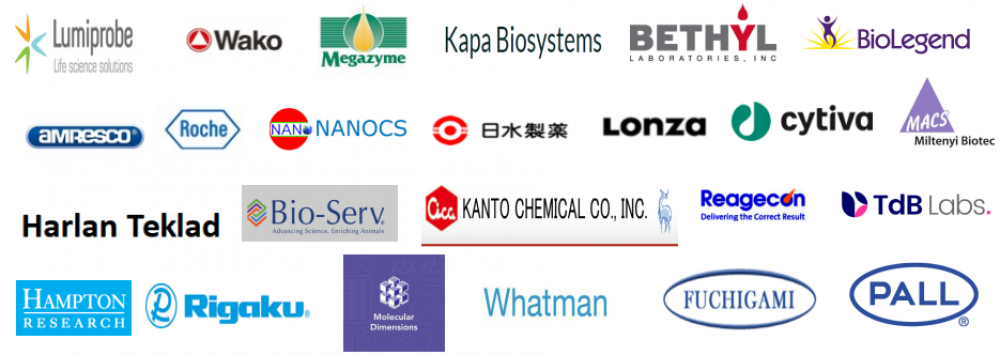DRAQ7;DRAQ5;Anthraquinone dye 蒽醌染料;DNA染料;7-AAD;碘化丙啶(PI);细胞活力分析;TMRM 线粒体膜电位探针;
DRAQ7是一种不具细胞通透性的远红外DNA染料,仅对死细胞和透化细胞的核染色,能与其它常见的标记染料(比如:GFP或FITC)联合使用。DRAQ7是一种理想工具用于研究死细胞或膜受损细胞,因其不用进入完整膜结构的活细胞。DRAQ7是碘化丙啶(PI)和7-AAD的理想替代品,因其不能被紫外激发,且与PE/PE同源物没有发射光重叠。
DRAQ7的关键特征包括:1)快速染色死细胞或透化细胞的dsDNA/核;2)低光漂白;3)适用于绝大多数细胞,真核和原核来源:哺乳动物、细菌、寄生虫、植物等;4)长期培养无毒性;5)能与活细胞染料结合使用;6)流式细胞检测中与常见的FITC/GFP+PE结合实验无需做荧光补偿;7)不用清洗或RNase处理;
染料特性
1) 外观:液体(0.3mM)
2) 激发波长:最理想633和647nm处(Eλmax= 599/644nm); 次理想488,514,568nm处(仅适用于流式分析)
3) 发射波长(取决于仪器):665nm至红外(Emλmax= 678nm/697nm,掺入 dsDNA)
与可见光区比如:GFP和FITC,最小重叠;发射滤片可能包括:695L, 715LP 或780 LP
3)与紫外/可见光荧光素的多波长成像:与DNA结合后没有荧光增强;低光漂白效应;兼容于流式细胞仪、激光扫描细胞仪和共聚焦显微镜的光学;以及基于灯泡的荧光显微镜。
保存与运输方法
保存:2-8°C避光保存,2年有效。不可冻存!
运输:室温运输。
注意事项
1)DRAQ7是Biostatus Limited的商标名。
2)荧光染料都存在淬灭的问题,保存和操作过程中注意避光。
3)为了您的安全和健康,请穿实验服并戴一次性手套操作。
染色步骤(悬浮细胞的活力染色)
1)对于每个样本,用PBS重悬细胞使其密度约为5×105细胞/ml。叠氮钠影响DRAQ7染色,建议用PBS(不含钙镁或叠氮钠)或细胞培养基(不含叠氮钠)来染色。
2)加入适量DRAQ7(0.3mM)到所需浓度。推荐做浓度滴定来确定最佳的工作浓度。用于流式细胞仪和显微成像检测,通常1:100的稀释倍数(3µM)能获得良好的染色结果。
3)室温避光孵育10-15min。不需清洗。
4)流式细胞仪分析。对于流式分析,当使用蓝色激光器激发,染料用PerCP-Cy5.5或PerCP-eFluor 710的滤片设置来观察;当使用红色激光器激发,染料用Cy5的BP或LP滤片设置来观察。另,当进行荧光显微镜分析,最好用黄-红光激发。用比如:695L, 715LP 或780 LP的远红长通滤片来观察。
延伸阅读(DRAQ7的动力学活力分析)
文献来源:Wlodkowic D, Akagi J, Dobrucki J, et al. Kinetic viability assays using DRAQ7 probe. Curr Protoc Cytom. 2013;Chapter 9:10.1002/0471142956.cy0941s65. doi:10.1002/0471142956.cy0941s65
实验1)DRAQ7实时染色(Real-time DRAQ7 staining)
①在合适的容器比如微量滴定板或细胞培养瓶内接种或分散细胞到培养基;
②加10μl DRAQ7储存液(浓度:300μM)到每1000μl细胞悬液(染料终浓度为3μM);
③轻轻混匀使染料均匀分散在溶液内;
④在含DRAQ7的情况下使细胞生长高达5天(37℃,5% CO2);
⑤定期收集染色样本用于流式分析;【细胞体积至少符合流式细胞仪分析要求的最低样本体积100-150μl】;
⑥不用清洗直接用流式细胞仪分析,用488nm激发器或633-647nm激发器,发射波长>660 nm。
关于DRAQ7的重要信息:DRAQ7培养高达5天对人细胞系无毒性,在高达20μM DRAQ7的体系内培养细胞,对细胞增殖、细胞周期、活力无明显干扰,且对药物比如抗肿瘤化合物或凋亡诱导剂没有反应。
结果呈现:
Figure 1 Assessment of live, early apoptotic and late apoptotic/necrotic cells based on stainability with plasma membrane permeability marker DRAQ7. Analysis was based on real-time labeling of THP-1 cells with 3 μM of DRAQ7. Bivariate dot plots DRAQ7 vs. forward scatter (FS) enable discrimination of live (DRAQ7−; green gate), early apoptotic (DRAQ7dim; blue gate) and late apoptotic/necrotic (DRAQ7+; red gate) subpopulations. DRAQ7 probe was excited using 633 nm laser and logarithmically amplified fluorescence signals were collected using 660 nm long-pass filter.
实验2)DRAQ7和线粒体膜电位敏感探针TMRM双重实时评估细胞死亡(Two color real-time assay with DRAQ7 and TMRM)
①在合适的容器比如微量滴定板或细胞培养瓶内接种或分散细胞到培养基;
②加10μl DRAQ7储存液(浓度:300μM)到每1000μl细胞悬液(染料终浓度为3μM);
③加15μl TMRM工作液(浓度:10μM)到每1000μl细胞悬液(染料终浓度为150nM);
④轻轻混匀使染料均匀分散在溶液内;
⑤在含DRAQ7和TMRM两种染料的情况下使细胞生长高达5天(37℃,5% CO2);
⑥定期收集染色样本用于流式分析;【细胞体积至少符合流式细胞仪分析要求的最低样本体积100-150μl】;
⑦不用清洗直接用流式细胞仪分析,用488nm激发器和633-647nm激发器,发射波长分别搜集575nm(TMRM)和>660 nm(DRAQ7)的信号。
重要信息:DRAQ7和TMRM两种染料都能被488nm激发器激发。两者相邻通道间的光谱重叠很小,如两者都用488nm激发器来激发,可能需做一些小补偿调整。DRAQ7荧光能用标准APC 660nm宽带滤片观察,当用633nm激发器来激发,避免使用任何荧光补偿。调整对数放大尺度来区分活细胞(明亮的TMRM+/DRAQ7−)、凋亡细胞(TMRMlow/DRAQ7−)、具受损质膜的晚期凋亡/坏死细胞(TMRMlow/DRAQ7+)。在一些细胞体系,可能有必要优化DRAQ7和TMRM浓度,以及PMT电压在不同的细胞时间中获得最大的分辨率。
Figure 2 Discrimination of viable, apoptotic and late apoptotic/necrotic cells based on Δψm marker
tetramethylrhodamine methyl ester (TMRM) and plasma membrane permeability marker DRAQ7. Analysis was based on real-time labeling of THP-1 cells with 3 μM of DRAQ7 and 150 nm of TMRM. Bivariate dot plots DRAQ7 vs. TMRM enable discrimination of live (TMRM+/DRAQ7−; green gate), early apoptotic (TMRMlow/DRAQ7dim; blue gate) and late apoptotic/necrotic (TMRMlow/DRAQ7+; red gate) subpopulations. DRAQ7 probe was excited using 633 nm laser and logarithmically amplified fluorescence signals were collected using 660 nm long-pass filter. TMRM was excited using 488 nm laser and logarithmically amplified fluorescence signals were collected using 575 nm long-pass filter. Debris signals were excluded electronically by setting the proper low threshold.
相关产品
| 名称 | 规格 | |
| Ethidium Bromide (EB)溴化乙锭 | 1g | |
| EB (10 mg/ml in Water) EB水溶液(10 mg/ml) | 5ml | |
| Propidium Iodide碘化丙啶(粉末) | 10mg | |
| Propidium Iodide (1mg/ml)碘化丙啶(1mg/ml) | 1ml | |
| Ethidium Monoazide Bromide (EMA)叠氮溴化乙锭 | 5mg | |
| Ethidium Homodimer 1 (EthD-1)溴乙啡锭二聚体1 | 1mg | |
| Ethidium Homodimer 3 (EthD-3)溴乙啡锭二聚体3 | 1mg | |
| 7-AAD (7-Aminoactinomycin D) 7-氨基放线菌素D | 1mg | |
| Acridine Orange Hydrochloride吖啶橙盐酸盐 | 1g | |
| DRAQ5 (5mM)远红外DNA染料 | 50µl | |
| Propidium Monoazide (PMA)叠氮溴化丙锭 | 1mg | |
| LDS 751 Nucleic Acid Stain核酸染色剂 | 25mg | |
| DRAQ7 (0.3mM)远红外DNA染料 | 250µl |
